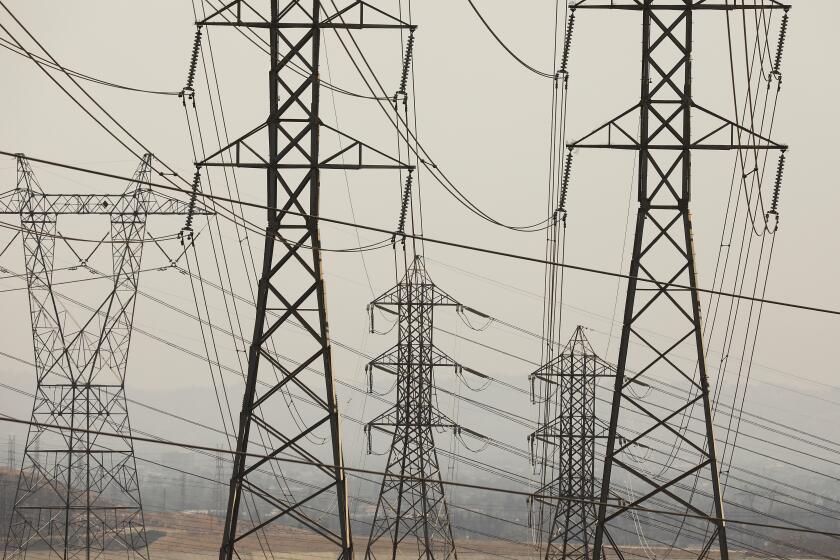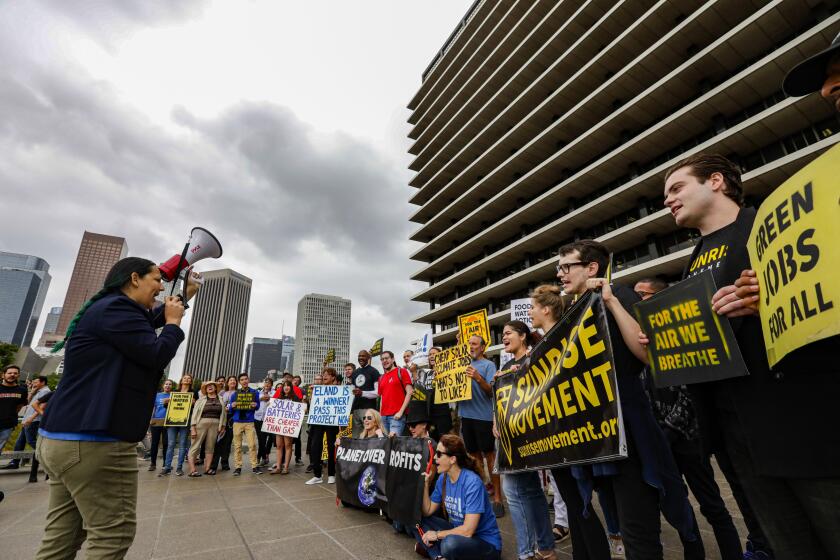For some Edison users, rates will be more costly than advertised

- Share via
As electricity bills rise with the temperature, some Southern California Edison customers are getting an extra jolt starting this month — and it’s one they didn’t see coming.
In April, Edison sent homeowners letters saying they were getting a new rate plan but their cost for electricity wouldn’t change.
One Santa Monica household’s notice, reviewed by The Times, showed the customer’s old rate was $1,030 per year. The new rate? Also $1,030 per year, the letter said.
But then a second letter from Edison arrived in the mail at the end of July. The new rate, the customer was told, would actually be $1,723 per year — a 67% increase that works out to nearly $60 a month. The first mailing had showed “an inaccurate rate analysis,” the new letter explained.
The Santa Monica homeowner, who didn’t want to be identified out of privacy concerns, wasn’t alone. The utility sent similar letters to 3,251 customers.
Although the notice seemed to blame bad math, Edison spokesperson Ron Gales had a different explanation. The “print agency erroneously double-printed” the old rates into the column that should have shown the new ones, Gales said.
Wildfires. Heat. Drought. Possible power shortages. The next month could be a tough one.
For ratepayers who don’t parse every mailing from their utility, the increase will come as an unpleasant surprise in bills this month, when a new “time-of-use” rate goes into effect. Under time-of-use rates, customers pay more for power during high-demand periods of the day.
Edison’s handling of the rate snafu drew criticism from consumer advocates, who think the state’s utilities need to do a better job communicating with customers about how their energy bills rise if they don’t change their behavior.
“It’s a printing thing not a math thing? It’s still their responsibility. That’s a nonsense statement,” said Mark Toney, executive director of the Utility Reform Network (TURN). “People have a right to be upset when they’re told one thing and it turns out to be something else.”
Gales said that Edison contacted all customers who’d switched to more expensive plans after the mailing — only 114 had made changes — and “added additional proofing steps with the print agency.”
The mailing mistake comes at a time when many people are likely to see higher power bills as they try to stay cool during warmer summer months by cranking up their air conditioning.
And electricity bills across California have been rising because of higher natural gas costs and investments needed to mitigate the risk of wildfires.
California utilities are transitioning customers to more grid-friendly rate plans. For thousands of people, this represents a price hike.
Against this backdrop, Edison has been in the process of shifting more than 2 million customers to new rate plans that charge more for energy during peak times. Advocates say low-income people and communities of color are likely to bear the brunt of these changes; they say policymakers and regulators need to do more to make energy equitable.
Most people won’t see rate jumps as high as the Santa Monica customer, Gales said, and the majority are projected to benefit under the new plan.
The Santa Monica resident was part of a smaller group of about 84,000 people — primarily rooftop solar customers — whose bills are likely to go up.
The new Edison rate plan takes a bit of explanation. California’s power grid is straining to keep up with demand as climate change means increasingly hot summers and the looming threat of blackouts.
To help with the problem, the California Public Utilities Commission ordered Edison, Pacific Gas & Electric and San Diego Gas & Electric to switch most customers to time-of-use rate plans. Under the new regimen, electricity costs more during peak hours of 4 to 9 p.m.
The idea is to incentivize using less electricity during times when solar power is less plentiful. People can save money if they concentrate their energy usage during off-peak hours.
Edison has switched about 2.2 million customers from standard “tiered” rate plans to time-of-use plans. People had the option to opt out of the time-of-use plan and remain on a standard plan, and about 609,000 residential Edison customers have chosen to do so.
The DWP has to modernize its rates to match the rapidly changing electricity market and facilitate the transition to cleaner, greener energy.
Even if customers made no changes to their energy usage, Gales said that 59% are projected to benefit on a time-of-use rate and an additional 20% are projected to see less than $30 in additional annual cost.
Consumer advocates have expressed concerns that time-of-use plans are more likely to benefit those who can afford to buy things such as smart thermostats and energy efficient appliances.
“Who is being affected? Who is paying more and who is paying less? Our big concern is that wealthy people would see their bills go down, and low-income people would see their bills go up,” said Toney of TURN.
“The ones who have the least control are the lower-income people who can’t shift their time of use as easily,” said Liza Tucker, a consumer advocate with Consumer Watchdog. She said policy changes were needed to decentralize the energy grid and “make things more equitable,” such as subsidizing solar panels and energy efficient appliances for low-income people.
Across California, low-income people are eligible for discounted electricity bills, but the program is very limited — a household of two, for example, must have an annual income of less than $36,620 to qualify. The Public Utilities Commission has done some studies of the effect of time-of-use plans on those in the discounted rate program and found that they do not shift their energy usage as much as higher-income customers, particularly in hotter climate zones.
Toney said that the PUC must analyze the data more broadly to see how time-of-use rates affect low-income people and communities of color, especially by climate zone.
Gales, the Edison spokesperson, said that about 900,000 low-income and medically vulnerable residential customers were exempted from the time-of-use transition.
Although Gales noted that Edison sends customers emails with tips on reducing energy usage under time-of-use plans, advocates pointed out that the utility doesn’t provide estimates of what people’s electric bills would look like if they shifted their usage to different times — which is supposed to be the whole point of time-of-use plans.
“If the utility doesn’t have a technical way of showing you that if you change your behavior, this is what your bill would look like, of course people are going to be horrified,” said Tucker of Consumer Watchdog. “I have to say that SCE is doing a terrible job on the communication front.”
But the utility said it doesn’t want to get into hypotheticals.
“We would have less confidence in those projections because they’re not based in the customers’ actual usage data,” Gales said.
More to Read
Inside the business of entertainment
The Wide Shot brings you news, analysis and insights on everything from streaming wars to production — and what it all means for the future.
You may occasionally receive promotional content from the Los Angeles Times.














